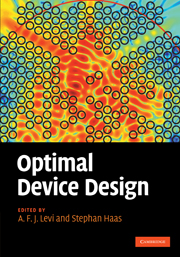Book contents
- Frontmatter
- Contents
- Preface
- Acknowledgements
- 1 Frontiers in device engineering
- 2 Atoms-up design
- 3 Electron devices and electron transport
- 4 Aperiodic dielectric design
- 5 Design at the classical–quantum boundary
- 6 Robust optimization in high dimensions
- 7 Mathematical framework for optimal design
- 8 Future directions
- Appendix A Global optimization algorithms
- About the authors
- Index
- References
4 - Aperiodic dielectric design
Published online by Cambridge University Press: 04 May 2010
- Frontmatter
- Contents
- Preface
- Acknowledgements
- 1 Frontiers in device engineering
- 2 Atoms-up design
- 3 Electron devices and electron transport
- 4 Aperiodic dielectric design
- 5 Design at the classical–quantum boundary
- 6 Robust optimization in high dimensions
- 7 Mathematical framework for optimal design
- 8 Future directions
- Appendix A Global optimization algorithms
- About the authors
- Index
- References
Summary
Introduction
The spatial arrangement of nanoscale dielectric scattering centers embedded in an otherwise uniform medium can strongly influence propagation of an incident electromagnetic (EM) wave. Exploiting this fact, one may iteratively solve a parameter optimization problem [1] to find a spatial arrangement of identical, non-overlapping scattering cylinders so that the scattered EMwave closely matches a desired target-response. Of course, the efficiency of adaptive algorithms used to find solutions may become an increasingly critical issue as the number of design parameters such as scattering centers increases. However, even for modest numbers of scattering cylinders this method holds the promise of creating nano-photonic device designs that outperform conventional approaches based on spatially periodic photonic crystal (PC) structures.
The configurations considered here consist of either lossless dielectric rods in air or circular holes in a dielectric similar to the majority of quasi two-dimensional (2D) PCs reported in the literature by, for example, [2, 3]. To confirm the validity of the 2D simulations they are compared to full three-dimensional (3D) simulations as well as measurements.
In Section 4.2 the forward problem and a semi-analytic method to compute the electromagnetic field distribution is introduced. The semi-analytic Fourier-Bessel series solutions and a guided random walk routine can be used for electromagnetic device design and the optimization algorithm is described in Section 4.3. The results of these design problems are presented in Section 4.4. The inefficiencies of the optimization routine in conjunction with the particular implementation of the forward solver soon became apparent. The presented types of aperiodic design demand highly efficient forward solvers as well as optimization routines.
- Type
- Chapter
- Information
- Optimal Device Design , pp. 88 - 122Publisher: Cambridge University PressPrint publication year: 2009

